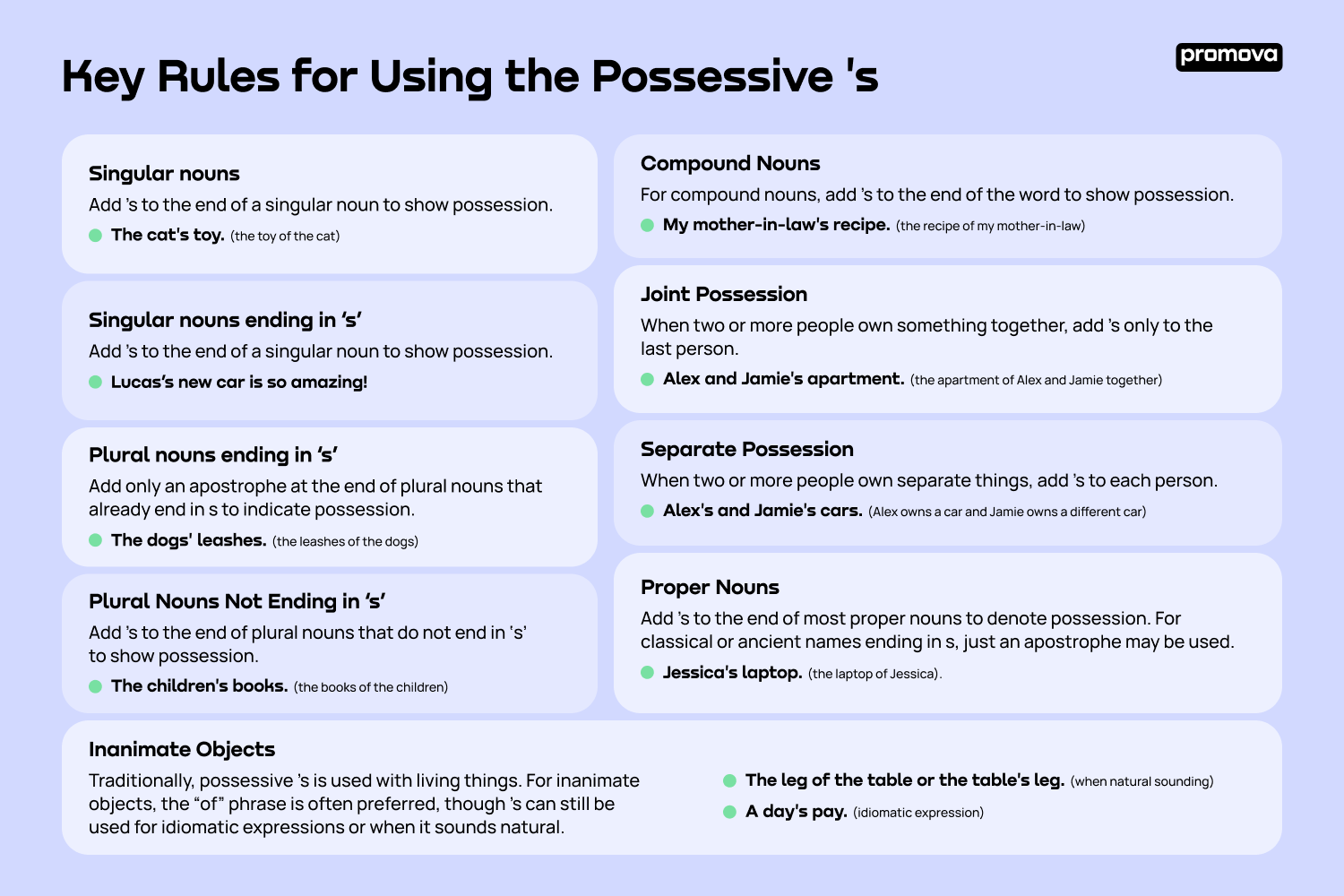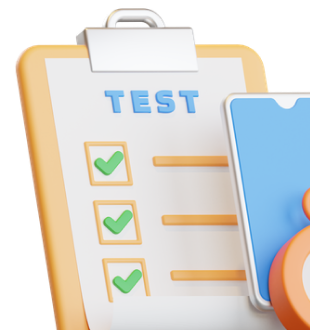Possessive S in the English language
Contents
The necessary skill in everyday communication is indicating ownership. The grammatical structures developed for this purpose help to avoid overwording and communicate effectively. Simultaneously, these structures are challenging for language learners. In this article, you will learn whether you should use ‘s or s' and how to remember the difference.
What are possessives?
Possessives are grammatical tools that show ownership or belonging. They answer the question, "Whose is it?" Possessive can be divided into two massive categories:
- Possessive nouns. The rules might vary, but in most cases, you have to add an apostrophe and the letter ‘s.’
- Possessive pronouns. This is an exhaustive list of pronouns used to indicate ownership: mine, yours, his, hers, ours, theirs, and its.
Seems simple, but there are many nuances, so let’s move on to them.
Key Rules for Using the Possessive 's
Understanding when and how to apply the possessive 's is crucial for effective communication. Here are the foundational possessive s rules:
| Rule | Example | |
| Singular nouns | Add 's to the end of a singular noun to show possession. | The cat's toy (the toy of the cat) |
| Singular nouns ending in s | Add 's to the end of a singular noun to show possession. | Lucas’s new car is so amazing! The octopus’s tentacles release toxins. |
| Plural nouns ending in s | Add only an apostrophe at the end of plural nouns that already end in s to indicate possession. | The dogs' leashes (the leashes of the dogs) |
| Plural Nouns Not Ending in S | Add 's to the end of plural nouns that do not end in s to show possession. | The children's books (the books of the children) |
| Proper Nouns | Add 's to the end of most proper nouns to denote possession. For classical or ancient names ending in s, just an apostrophe may be used. | Jessica's laptop (the laptop of Jessica). Jesus' teachings (the teachings of Jesus). |
| Compound Nouns | For compound nouns, add 's to the end of the word to show possession. | My mother-in-law's recipe (the recipe of my mother-in-law) |
| Joint Possession | When two or more people own something together, add 's only to the last person. | Alex and Jamie's apartment (the apartment of Alex and Jamie together) |
| Separate Possession | When two or more people own separate things, add 's to each person. | Alex's and Jamie's cars (Alex owns a car and Jamie owns a different car) |
| Inanimate Objects | Traditionally, possessive 's is used with living things. For inanimate objects, the “of” phrase is often preferred, though 's can still be used for idiomatic expressions or when it sounds natural. | The leg of the table or the table's leg (when natural sounding). A day's pay (idiomatic expression). |
By mastering these rules and applications, you'll enhance your ability to communicate complex relationships and ownerships succinctly. Remember, the goal is not just to follow rules but to use them to create clear, engaging, and effective communication.
3
Common Mistakes in Using the Possessive 's in English
Some of our learners say that the possessive grammar rules are easy to understand. However, many language learners face challenges using the possessive s. It’s a normal situation for any person since languages have never been a simple thing. We have collected the most common mistakes to help you master using possessives.
- Confusing its vs it's. This is the most frequent errors. Its vs it’s have the same pronunciation. The only difference is adding an apostrophe. The challenge is that the ‘s part usually indicates a possessive form. However, “it’s” is a contraction of “it is” or “it has.” The possessive pronoun is “its.”
- Correct: The cat licked its paws.
- Incorrect: The cat licked it's paws.
- Misplacing the apostrophe in plural possessives. This is another common mistake. Learners quickly remember that possessive s in singular nouns goes after apostrophe. But in plural nouns ending in “s,” the apostrophe should come after the s.
- Correct: The students' books were scattered on the floor.
- Incorrect: The student's books were scattered on the floor. (This suggests belonging to one student.)
- Overusing with inanimate objects. This is not a grammatical mistake, but often leads to weird constructions. It’s recommended to use the “of” phrase with inanimate objects.
- Preferred: The roof of the house was leaking.
- Less Preferred: The house's roof was leaking.
- Misplacing apostrophes in compound nouns. Compound nouns are very challenging in terms of possessive grammar. Usually, language learners place ‘s’ after the first word, which is incorrect. Remember to use possessive s at the end of the last word in compound nouns.
- Correct: My mother-in-law's advice was invaluable.
- Incorrect: My mother's-in-law advice was invaluable.
- Neglecting possessive s with singular nouns ending in S. Such words used with possessive s seem to be awkward. That is why learners often add the apostrophe to the end of the word, which is a mistake.
- Correct: The boss's car is parked outside.
- Incorrect: The boss' car is parked outside. (Though accepted in some style guides, it may confuse readers unfamiliar with the rule.)
- Forgetting to use an apostrophe. This is the most unpleasant mistake. Remember to use apostrophes, as they’re a key element in possessive grammar rules.
- Correct: We visited the Smith’s house last weekend.
- Incorrect: We visited the Smiths house last weekend. (This implies visiting the house or family of one Smith.)
How to avoid all these pitfalls? You have to learn the rules and practice them through different exercises. With time and attention, mastering the possessives will become second nature, enhancing both your written and spoken English.

Conclusion
The possessive 's is a powerful tool in English, adding nuance and precision to your writing. By mastering its rules and applications, you'll enhance your ability to communicate complex relationships and ownerships succinctly.



Comments